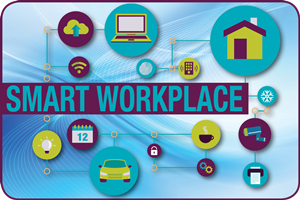Is Your Workplace Smart? (The Guardian: 15/08/2017)

With all the buzz around Smart Cities and Smart Buildings, isn’t it time we also start creating Smart Workplaces? So what exactly are Smart Workplaces and how do they relate to Workplace Wellness?
A new report from CBRE Global Workforce identifies five demographic and social tends that are driving interest in Wellness in a Smart Workplace
Trend 1: Employees are living and working longer – According to the World Bank, average life expectancy globally for men and women has increased by 2 years since 2005. Organizations that make the most of the skills and experience of older workers stand to gain a competitive advantage by developing a pool of highly experienced, flexible retirees as interim or short-term temporary consultants or contractors.
Trend 2: Declining health and rising healthcare costs – While we are living longer, we are not necessarily living healthier lives. According to the World Health Organization, worldwide obesity has nearly doubled since the 1980s and non-communicable diseases such as heart disease, cancers, and diabetes now account for more than 60 percent of all deaths worldwide. The cost of doing nothing is too high. Increasingly smart companies are supporting and promoting healthy lifestyle choices that encourage exercises, healthy eating options, and onsite wellness programs.
Trend 3 – Key skills are hard to find – There is a shortage of skills and talent is at a premium. Recruiting employees with right skills and then retaining them is costly and highly competitive. According to a CoreNet survey conducted in 2014, 80% of employees say wellness programs will be crucial in recruiting and retaining them over the next 10 years.
Trend 4 – A growing awareness of stress and mindfulness – Stress is experienced by most people during a normal working week and is a major cause of burnout and depression. Balancing private and professional commitments is increasingly cited as a challenge. We habitually reach for our phone over 150 times a day and many of us rarely disconnect for fear of missing out. This can leave people unable to re-charge which in turn causes stress. As one of the consequences, there is a growing awareness of mindfulness and mental wellbeing.
Trend 5 – Technology is making it easier for people to monitor and manage their health – Increasingly medical treatment is not restricted to the clinic. Digital technology and M-Health are empowering people to monitor their health and use that data to mange their wellbeing. Brands like Apple, Nike and Garmin already offer a huge array of gadgets and apps to help us get fitter, faster and stronger. Biometric sensors and wearable technologies act as an enabler to proactively manage personal health. Progressive employers use this data to create supportive and desirable working environments, increasing productivity and reducing presenteeism.
These trends are an opportunity for organizations to boost their competitiveness, attract talent and manage their employee costs by introducing wellness initiatives.
Reply back to bhakti@impactafya.com or call +255 754 694 643 with your feedback. We welcome your suggestions for corporate wellness tips you’d like to see covered in our future columns.
Bhakti Shah, MPH is the Founder and Managing Director of ImpactAfya Ltd, collaborating with Workplace Options and Mayo Clinic, USA to provide Corporate Wellness and EAP Solutions in East Africa. Bhakti is also the Advisor for the Africa Business Portal and the Past President of the American Chamber of Commerce in Tanzania.
Website: www.impactafya.com | Facebook, Instagram & Twitter: @impactafya
